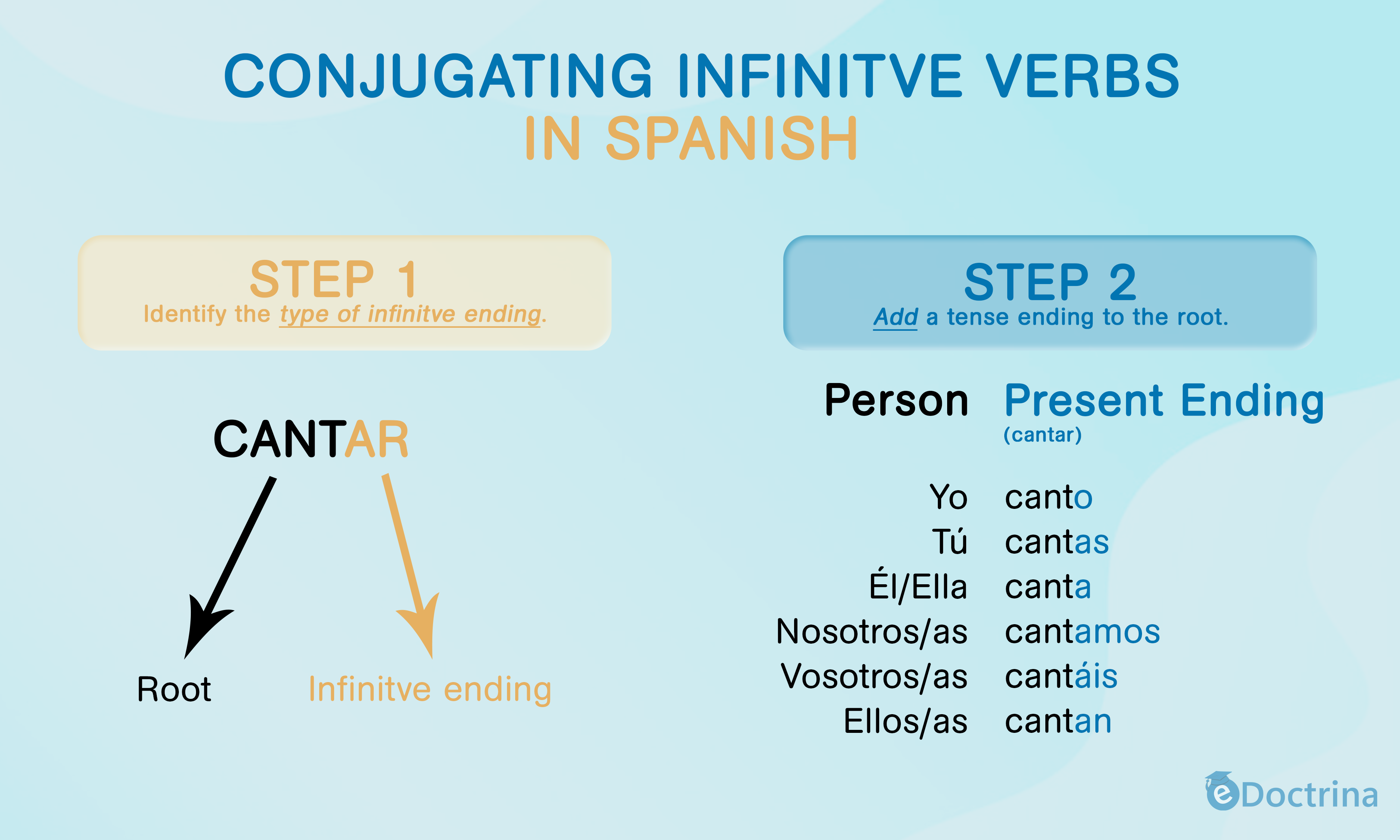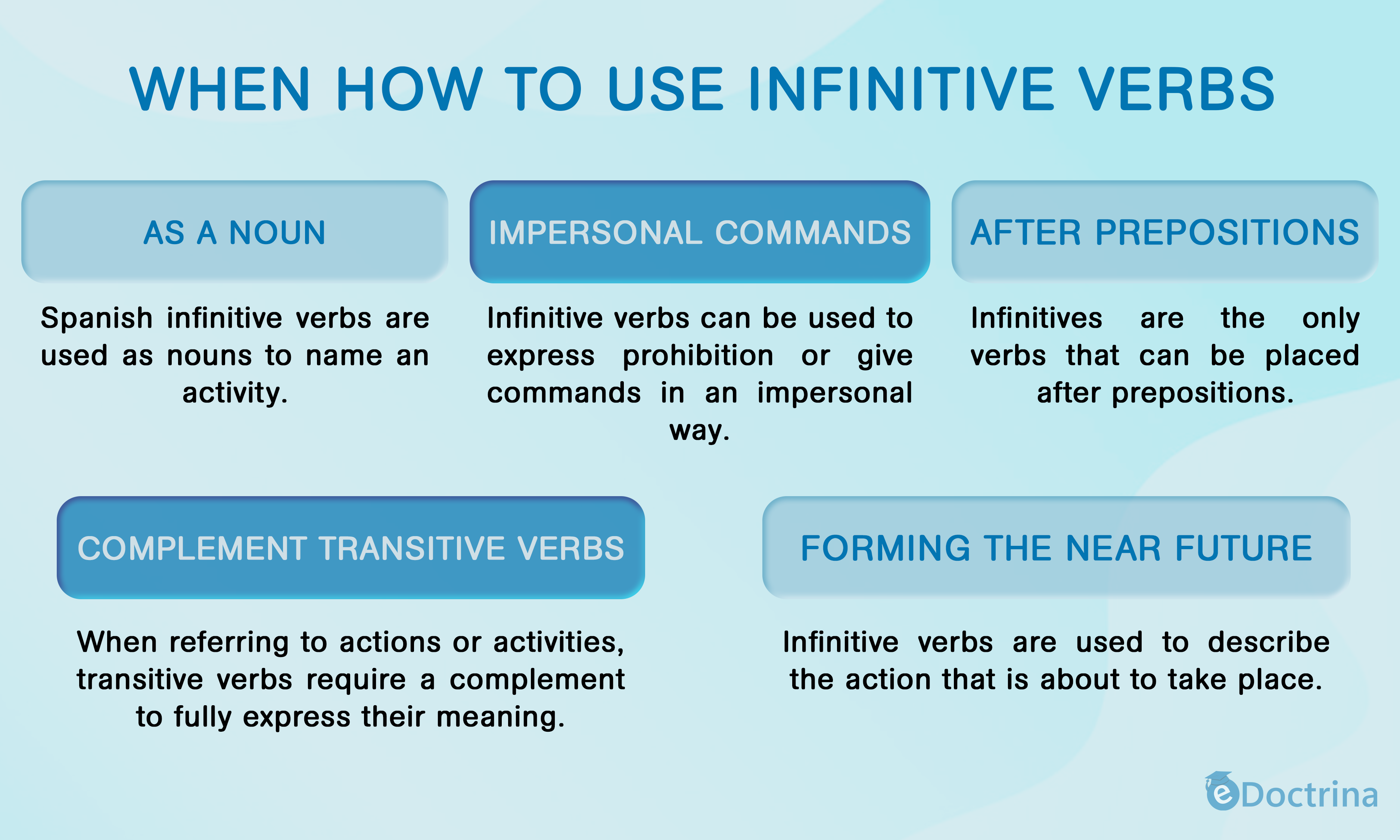Are you familiar with the concept of infinitive verbs in Spanish? Infinitives play a pivotal role in determining the conjugation pattern you should employ (-ar, -er, -ir).
However, beyond this, they encompass other fundamental yet crucial applications that demand your attention.
To simplify and enhance practicality, I’ve incorporated examples throughout the guide.
Let’s get started:
Understanding Spanish Infinitive Verbs
Spanish infinitive verbs exist in their most fundamental form, representing verbs that are not yet conjugated. Consequently, infinitives neither specify the performer of the action nor the timing of its occurrence. Identification of infinitive verbs in Spanish is facilitated by the endings -ar, -er, or -ir.
As highlighted earlier, Spanish verbs feature three distinct infinitive endings: -ar, -er, and -ir. For instance:
- -AR verbs: hablar, bañarse, amar.
- -ER verbs: comer, tener, ponerse.
- -IR verbs: vivir, decir, salir.
It’s noteworthy that reflexive verbs also adopt these infinitive endings, positioned before the pronoun “se” to indicate their reflexive conjugation.

Generally, words concluding with -ar, -er, and -ir are infinitive verbs. Yet, there are exceptions to this rule, including words like ‘mujer,’ ‘militar,’ and ‘mártir.’
In the sections that follow, you’ll discover that infinitive endings serve as indicators for the conjugation patterns required when expressing Spanish verbs in various tenses.
Kindly observe: Important to keep in mind while all three infinitive forms hold significance, it’s worth noting that over 80% of the verbs you’ll encounter conclude with -AR. In essence, -AR verbs stand out as the most prevalent type of verbs in Spanish.
Conjugating Infinitive Verbs in Spanish
Infinitive verbs are conjugated to indicate the timing and performer of an action.
To conjugate an infinitive verb in Spanish, one must substitute the infinitive ending (-ar, -er, or -ir) with a conjugated ending. In simpler terms, a tense ending is added to the verb’s root.
Consider the examples of hablar and comer.
Yo hablo español.
I speak Spanish.
Ayer comí muchas manzanas.
Yesterday, I ate many apples.

In Spanish, –ar, -er, and -ir verbs exhibit distinct conjugation endings based on the subject pronoun and the desired tense (specific moment in time). Refer to the illustration above for a visual example.
Kindly observe: Important to keep in mind verbs constitute one of the nine parts of speech in Spanish, playing an essential role in sentences by indicating the performance of an action. For comprehensive coverage of conjugation endings in various tenses, refer to my guide on the most common tenses in Spanish.
Attaching pronouns to an infinitive
Spanish infinitive verbs frequently associate with reflexive, direct, or indirect object pronouns. When the infinitive serves as the sole verb in a sentence, these pronouns must be affixed to it. Unlike English, where they remain separate entities, Spanish infinitive verbs and pronouns merge into a single word.
Here are illustrative examples:
La maestra quiere verte.
The teacher wants to see you.
¿Y las verduras? Voy a lavarlas.
And the vegetables? I’m going to wash them.
Es importante cepillarse los dientes todos los días.
It’s important to brush your teeth every day.
Kindly observe: Important to keep in mind in instances where the infinitive verb follows a conjugated verb (as seen in examples #1 and #2), you have two choices. You can either append the pronoun to the infinitive or position it before the conjugated verb.
La maestra te quiere ver.
The teacher wants to see you.
Do you want to learn more?
Join the e-Doctrina Spanish community and learn basic Spanish communication in a carefully graded way for beginners.
Utilizing Spanish Infinitive Verbs: Timing and Techniques
In addition to aiding in the identification of required conjugation models, Spanish infinitives serve various purposes:
- As nouns
- For providing impersonal commands
- As complements for transitive verbs
- Following specific prepositions
- To constitute the near future tense

Explore the following sections to delve deeper into these applications and the corresponding structures required for each.
As a Noun
Spanish infinitive verbs function as nouns to designate an activity. In such sentence structures, the infinitive verb may serve as the subject of the sentence:
[Infinitive verb] + [complement]
Aprender español es fácil y divertido.
Learning Spanish is easy and fun.
Viajar y conocer otros lugares es emocionante.
Traveling and knowing other places is exciting.
Kindly observe: While the majority of English -ing verbs align with Spanish present participles (also known as gerunds), when an -ing verb operates as a noun, it is imperative to consistently employ an infinitive verb in Spanish.
To Give Impersonal Commands
A prevalent application of infinitive verbs in Spanish is to convey prohibition or deliver commands in an impersonal manner. In this context, you are not directing the communication towards a specific individual but rather addressing anyone who comes across the sentence.
(No) + [infinitive]
No correr.
No running.
Sazonar las verduras al gusto.
Season the vegetables to your liking.
Kindly observe: For direct commands to someone, it is necessary to utilize the verb in its imperative form.
Complementing a Transitive Verb
Spanish transitive verbs require a complement to convey their complete meaning. When describing actions or activities, this complement often takes the form of an infinitive verb. Here are examples of verbs that are followed by infinitives:
- Querer – To want
- Poder – To can
- Gustar – To like
- Deber – To have to / To must to
- Soler – To use to / To tend to
- Decidir – To decide
- Esperar – To wait
- Preferir – To prefer
- Recordar – To remember
- Desear – To wish
- Intentar – To try
- Tener que / Hay que – To have to
- Recomendar – To recommend
- Sugerir – To suggest
[Verb conjugated] + [infinitive verb]
Me gusta mucho leer.
I like reading a lot.
Queremos aprender español.
We want to learn Spanish.
No pude terminar mi tarea.
I couldn’t finish my homework.
Following Prepositions in Spanish
Only infinitive verbs in Spanish can be positioned after a preposition. Here are examples of such sentences:
[Preposition] + [infinitive verb]
Voy a hablar con ella.
I’m going to talk to her.
De querer sí quiero, pero no puedo.
I want to, but I can’t.
Necesito algo para limpiar las ventanas.
I need something to clean the windows.
Kindly observe: Numerous constructions involving Spanish prepositions defy literal translation into English. For instance, dejar de (stop doing something), volver a (do something again), acabar de (just finish doing something).
Constructing the Near Future Tense in Spanish
Spanish infinitive verbs are employed to convey that an action is imminent in the near future. This construction, known as the near future tense, involves using the structure ir + a + infinitive to articulate this temporal context:
[Present form of ‘ir’] + a + [infinitive verb]
¿Cuándo vas a llegar?
When are you arriving?
Mañana no vamos a trabajar.
We’re not working tomorrow.
Kindly observe: Observe that infinitives are utilized to depict the impending action. The verb ir indicates the individual or entity set to execute the action.
Essential Highlights
Mastering the usage of infinitive verbs in Spanish is a pivotal step towards enhancing your language proficiency. Here are some fundamental points to engrain in your understanding:
- A verb in its infinitive is an unconjugated verb. It doesn’t describe who performed an action (subject) or when it occurred (tense).
- Spanish features three types of infinitive verbs: -ar, -er, and -ir.
- The endings -ar, -er, and -ir signify the conjugation model of a verb.
- Conjugating infinitive verbs involves adding a tense ending to the verb’s root.
- Reflexive and object pronouns can be attached to a Spanish infinitive verb.
- Infinitive verbs in Spanish serve various purposes:
- As nouns (correr es bueno para la salud)
- To complement transitive verbs (quiero viajar)
- To give impersonal commands (no fumar en esta área)
- After a preposition (voy a ver una película)

